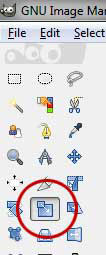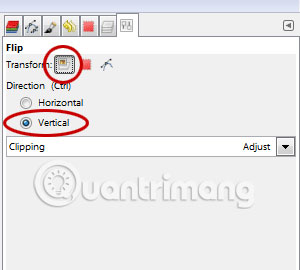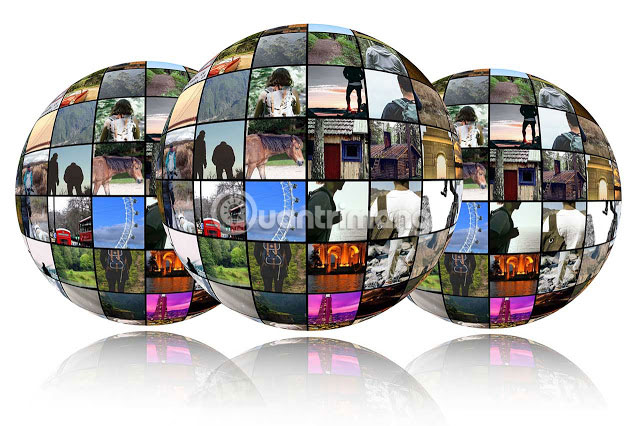How to create spherical images in GIMP
In this tutorial, we will learn how to create a spherical collage using Ellipse Select Tool ( Tools> Selection Tools> Ellipse Select ) and the Spherize filter ( Filters> Distorts> Spherizee ) included with GIMP. To create reflection, we'll use a layer mask ( Layer> Mask> Add Layer Mask ) and the gradient tool ( Tools> Paint Tools> Gradient ). You can experiment with many tools in GIMP to add your own artistic effects. Let's get started!
Instructions for creating spherical images using GIMP tool
- 1. Open the image in GIMP
- 2. Add Transparency (transparency)
- 3. Draw the circle selection
- 4. Apply Spherize filter
- 5. Delete the background
- 6. Change the spherical collage size with Scale Tool
- 7. Move the spherical image using the Move tool
- 8. Duplicate the layer to create a reflection effect
- 9. Flip vertically
- 10. Add layer mask
- 11. Apply Gradient
- 12. Create New Layer From Visible
- 13. Save the document
1. Open the image in GIMP
First, join multiple photos into one frame using GIMP, then export that collage in JPEG format.
Use the File> Open command . in the top menu, or press Ctrl + O to open the image. The 'Open Image' dialog box will appear, allowing you to navigate to the file you want to find and click its name. Navigate through the folders in the Places panel and Name until the image name appears in the Name table . Click on the image you want to open. When the image file is selected, you can view the preview of the image file on the right side of the box (although it's not easy to find a thumbnail-based image). Click the Open button .


2. Add Transparency (transparency)
Alpha channel represents transparency of the image. Because this image has only one layer, this background layer does not have an Alpha channel. Use Layer> Transparency> Add Alpha Channel to add transparency.
3. Draw the circle selection
Select Ellipse Select Tool from Toolbox or use Tools> Selection Tools> Ellipse Select (E) . Click and drag the mouse to select the part you want to grab in the image. Release the mouse when done. You will see a dotted line around the selection.


4. Apply Spherize filter
Go to Filter> Distort> Spherize to apply the Spherize filter. The Spherize dialog box appears. Here, you can set Mode to Radial, Angle of View to 0 , Curvature to 1 , Amount to 1 , Resampling Method to Linear and select Use the selection as input . Click OK.

5. Delete the background
Go to Select> Invert to invert the selection and delete the background by going to Edit> Clear . Now, we have a spherical image. Use Select> None to delete the selection.


6. Change the spherical collage size with Scale Tool
Use Tools> Transform Tools> Scale to change the size of the spherical image you just created. Click anywhere in the collage. In the Scale dialog box , click the chain icon to keep the collage from distortion. Manually enter new values for the width and height of the image or through the up and down arrows. Click the Scale button when you're done.


7. Move the spherical image using the Move tool
Use Tools> Transform Tools> Move to move the spherical image. Click and hold anywhere inside the image then drag.


8. Duplicate the layer to create a reflection effect
Use Layer> Duplicate Layer (or by using the keyboard shortcut Shift + Ctrl + D ). A new layer is an almost identical copy to the active layer that will be added to the image. Rename the new layer copied to Reflection.
Now, select the layer just copied on the Layers dialog . Click on the Move Tool icon or use Tools> Transform Tool> Move , then click and hold anywhere in the copy layer, then drag it below the original layer.



9. Flip vertically
Select the Reflection layer on the Layers dialog. Use Tools> Transform Tools> Flip or just press Shift + F to flip the Reflection layer. Select the Tool Options dialog box. Select Layer for Transform and under Direction, select Vertical. Click on the image to flip it vertically.





10. Add layer mask
Make sure that the Reflection layer is selected on the Layers dialog . Use Layer> Add Layer Mask . The Add Layer Mask dialog box will appear. Here, you can choose 'White (Full Opacity)' .


11. Apply Gradient
Select the Gradient Tool from the Toolbox or use Tools> Paint Tools> Gradient . Select the Tool Options dialog box and set FG to BG. Make sure the foreground and background colors are black and white by pressing the D key on the keyboard. Click the layer mask box. Apply the gradient by clicking and dragging the document from bottom to top.





12. Create New Layer From Visible
Move to Layer> New from visible . This will merge the visible layers into a new layer above the top. You can duplicate this new layer and arrange it as you like.

13. Save the document
Use File> Save in the top menu, or press Ctrl + S to save the created image file. The Save Image dialog box will appear. Navigate to the folder where you want to save the file. Enter a name in the Name text box and select the default GIMP (* .XCF) format. XCF is GIMP's original format and is very useful because it stores everything about images, as well as allows you to edit images in GIMP later, in case you notice any problems that arise after finish. Click Save to save the file.
Once completed, you'll probably also want to export images in a more widely used format, such as JPEG, PNG, TIFF, etc.
Here are the results:

Hope you are succesful.
You should read it
- How to delete any details in the image with GIMP
- Create ghosts in Photoshop or GIMP
- How to create clipping mask in GIMP
- How to automate GIMP by script
- How to create a poster with the Text Portrait effect in GIMP
- How to create semi-transparent images in GIMP
- Merge multiple photos into one common frame using GIMP
- How to use Paintbrush in GIMP
May be interested
- Why are the stars in the universe spherical and not square or rectangular?
 the stars and planets in the universe have different sizes and masses, but they are all spherical. so why are they all spherical and not any other shape?
the stars and planets in the universe have different sizes and masses, but they are all spherical. so why are they all spherical and not any other shape? - How to create animations and GIFs using GIMP on PC
 gimp tool is an open source photo editing software, suitable for editing beautiful photos or creating animations with gimp. with powerful built-in tools, gimp is not only on par with photoshop but also superior in many other aspects.
gimp tool is an open source photo editing software, suitable for editing beautiful photos or creating animations with gimp. with powerful built-in tools, gimp is not only on par with photoshop but also superior in many other aspects. - New features of GIMP version 2.10
 starting to develop from 2012, gimp 2.10 comes with an image processing tool, a redesigned interface, as well as a host of new features and tools.
starting to develop from 2012, gimp 2.10 comes with an image processing tool, a redesigned interface, as well as a host of new features and tools. - How to create movie posters in GIMP
 do you believe you can design an impressive movie poster without going to photoshop? that's right, in this tutorial, tipsmake.com will show you how to create a great movie poster by drawing, editing and free gimp graphic design.
do you believe you can design an impressive movie poster without going to photoshop? that's right, in this tutorial, tipsmake.com will show you how to create a great movie poster by drawing, editing and free gimp graphic design. - How to Make Business Cards with GIMP
 gimp is a free image editing program that can do a lot of different things, including making business cards. while there aren't any easy templates to use in gimp, you can create professional cards with just a few of gimp's basic tools. you...
gimp is a free image editing program that can do a lot of different things, including making business cards. while there aren't any easy templates to use in gimp, you can create professional cards with just a few of gimp's basic tools. you... - How to arrange brushes in GIMP with tags
 thanks to its plugins, add-ons, and deep level of customization, gimp is a staple of many proficient users' workflows.
thanks to its plugins, add-ons, and deep level of customization, gimp is a staple of many proficient users' workflows. - 8 best GIMP plugins and how to install them
 the plugin turns gimp into a great program. they add new features, improve user workflows and make gimp one of the best free alternatives for photoshop.
the plugin turns gimp into a great program. they add new features, improve user workflows and make gimp one of the best free alternatives for photoshop. - How to draw borders for text in GIMP
 using the free gimp image editing application, you can also create custom text and create outline for it with colored borders to your liking.
using the free gimp image editing application, you can also create custom text and create outline for it with colored borders to your liking. - How to cut advanced photo collage in GIMP
 in this tutorial, tipsmake.com will show you how to combine some excellent editing and image processing techniques in gimp with graphic design techniques, to create an impressive layout for the works. mine.
in this tutorial, tipsmake.com will show you how to combine some excellent editing and image processing techniques in gimp with graphic design techniques, to create an impressive layout for the works. mine. - How to create clipping mask in GIMP
 clipping mask is much simpler than we imagine. basically, they apply layer masks to a group of layers.
clipping mask is much simpler than we imagine. basically, they apply layer masks to a group of layers.










 How to rotate text in Photoshop
How to rotate text in Photoshop How to write curves in Photoshop
How to write curves in Photoshop How to create a custom Color Palette in Adobe Photoshop
How to create a custom Color Palette in Adobe Photoshop How to change the layer size in GIMP
How to change the layer size in GIMP Top app to turn photos into paintings on the phone
Top app to turn photos into paintings on the phone How to hide personal information, image content on Redacted
How to hide personal information, image content on Redacted